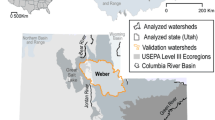Abstract.
Strategies for protecting and restoring riparian and stream ecosystems commonly encounter uncertainties about natural processes and management practices that contribute to environmental disturbances. Improvements in management plans require landscape approaches that account for the explicit spatial distribution and variability of different land cover types that can contribute to unstable conditions. We use a spatially explicit procedure to determine erosion-risk indices and variable riparian buffer widths in watersheds. The indices are based on land cover types that can contribute to erosion either alone or collectively. Land cover information (e.g., unstable soils, immature forest stands, roads, critical slope for land failure and rain-on-snow areas) was used to estimate erosion-risk indices. Erosion-risk indices increase with greater co-occurrences of contributing land covers. The procedure was used to identify erosion-prone areas in tributary watersheds of the Beckler-Rapid River drainage (260 km2), in the State of Washington, USA. A regression analysis of the relationship between mean sediment inputs to streams and erosion-risk indices of sixteen different watersheds indicated that erosion-risk indices explained 65% of the variation associated with sediment inputs to channels. Landscape maps of erosion-risk categories, based on ranges of erosion-risk indices, allowed spatially explicit definitions of stream reach lengths susceptible to different levels of erosion. Low to high-risk categories, and reach lengths vulnerable to erosion, also permitted the identification of the distribution of channels requiring protection by variable riparian buffers widths. The applicability of the procedure to other landscapes was demonstrated by estimating erosion risk-indices and variable riparian buffer widths for watersheds in the upper Cedar River drainage near Seattle, Washington. This approach allows watershed managers to use existing records and published information to address environmental problems within highly variable landscapes.
Similar content being viewed by others
Author information
Authors and Affiliations
Corresponding author
Additional information
Received: 25 August 2003; revised manuscript accepted: 26 March 2004
Rights and permissions
About this article
Cite this article
Wissmar, R.C., Beer, W.N. & Timm, R.K. Spatially explicit estimates of erosion-risk indices and variable riparian buffer widths in watersheds. Aquat. Sci. 66, 446–455 (2004). https://doi.org/10.1007/s00027-004-0714-9
Issue Date:
DOI: https://doi.org/10.1007/s00027-004-0714-9




